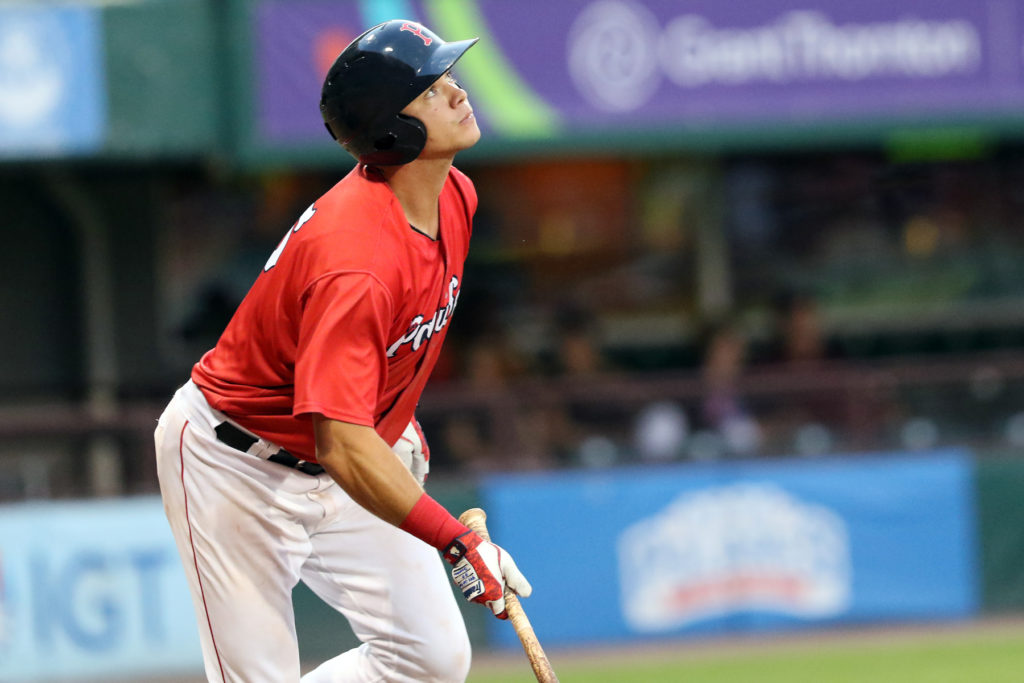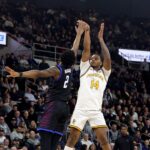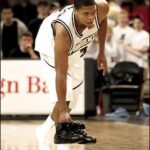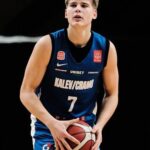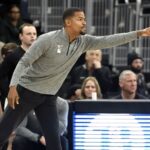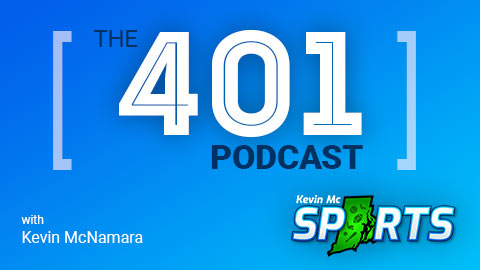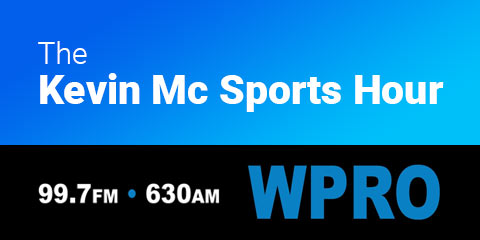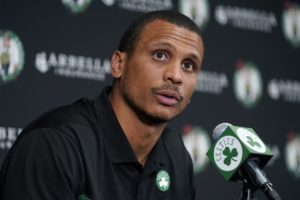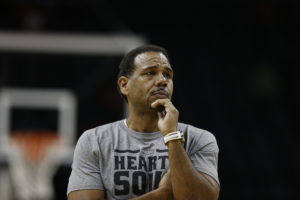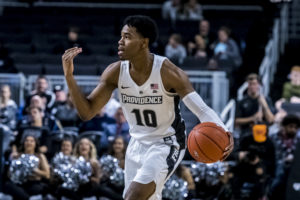Bobby Dalbec 2021 looks a lot more advanced than the Bobby Dalbec 2019 we saw for a brief period in Pawtucket (above). Is that improvement real? (Photo: Louriann Mardo-Zayat)
By ART MARTONE
There’s an old saying in baseball: Don’t believe what you see in September, and don’t believe what you see in March.
Too bad, because — boy — there’s a lot to like in what we’re seeing from Bobby Dalbec:
THAT'S A BOBBY DALBEC GRAAAAAAAAAND SLAAAAAAAAAAAAM@BobbyDalbec | @RedSox pic.twitter.com/5Oku60fczO
— NESN (@NESN) March 10, 2021
As I write this, Dalbec has homered four times in the eight games in which he’s appeared this spring. You know how some player will drive in three runs in the first two games of a season and someone will invariably say: “Hey, he’s on pace for 243 RBIs”? Don’t you hate that? Well then, you’re really going to hate this: If he produces at this rate in the regular season, Dalbec will finish with 81 home runs.
Luckily, some are more grounded in reality than I:
They laughed at me when I said Bobby Dalbec would hit 46 home runs this year. He might hit 70. Before the All Star break. https://t.co/00hA8CIiai
— Jared Carrabis (@Jared_Carrabis) March 10, 2021
Or maybe not.
Okay, okay. Enough. Put September aside for a moment (even though that’s when most of what we saw from Dalbec last year happened). There’s a very good reason — actually, many very good reasons — why you can’t believe what you see in March. Pitchers are more concerned with rounding into regular-season form than actually getting anyone out. They won’t necessarily throw to hitters in spring training the way they will in the regular season. Nobody’s really trying to win. It’s why they call them exhibitions.
The thing is, it’s so easy to be blinded by the seductive sun of a Florida spring . . .
At the start of spring training in 2013, the Red Sox had no intentions of bringing Jackie Bradley Jr. with them when they went north for the start of the regular season. The most advanced member of the golden Red Sox draft class of 2011 — so golden that old friend Alex Speier wrote a book that focused heavily on it — Bradley was thought to be at least a year away when camp opened. But that was no problem; the Sox still had Jacoby Ellsbury in center field. It was widely assumed Ellsbury would be departing as a free agent at the end of the ’13 season (which he did), and the Sox were counting on a relatively seamless transition to the JBJ Era.
But when the exhibition games began, Bradley started to hit. He never stopped. The Sox, in spite of themselves, were enchanted. The details of the situation were perhaps best described in this video by a Red Sox fan called ThisWeekInRed.
When camp ended, JBJ’s stat line was something the present-day Mike Trout or Mookie Betts would envy:
| G | AB | R | H | 2B | 3B | HR | RBI | BB | K | SB | CS | AVG | OBP | SLG | OPS |
| 28 | 2 | 13 | 26 | 4 | 1 | 2 | 12 | 10 | 10 | 2 | 1 | .419 | .507 | .613 | 1.120 |
And in his first major-league at-bat — in Yankee Stadium, no less — the inimitable duo of Don Orsillo and Jerry Remy saw things in Bradley that they thought boded very well for his future:
From Orsillo: Because of these numbers that he put together in spring training, (then-Red Sox manager) John Farrell said when asked what he was surprised about most . . . said, “How good Jackie Bradley Jr. is. Heard about him, saw the numbers, but until you see him in person it changes everything. It changed everything to the point where he makes this team.“
But it was all a mirage.
Bradley wasn’t ready, and in fact never reached the offensive heights he seemed destined for that spring in Fort Myers. In 37 games with the Sox in ’13, he put together a slash line of .187/.280/.337 before being sent back to Pawtucket. He struggled just as badly in 2014, hitting .198 in 127 games. He didn’t take over the starting center-field job until 2016, three seasons later than the Sox had hoped, and ended his Boston career with a .239 batting average and .732 OPS. His OPS+ was 94 (100 is considered average). His defense, of course, was consistently excellent, but everybody always knew about his glove. It was his bat that dazzled people in 2013.
In March.
In that case, though, we saw things that proved not to be there. In other cases, we see things we know aren’t there.
The saga of Bill Buckner in Boston had a coda that very few people are apparently still aware of. Game 6, 1986? Yeah, that we all remember. We also remember, or many of us do, the Red Sox releasing him in mid-season 1987. It all led to this syrupy “All is forgiven, Billy Buck!!” moment on Opening Day 2008:
Except that wasn’t the first time Buckner had been welcomed back to a raucous Opening Day standing ovation at Fenway Park:
Remember that?
Yeah, I didn’t think so. It had happened for the first time 18 years earlier, after Buckner had — improbably — earned a roster spot after wrangling a spring-training invite at age 40.
And how had he done it? By hitting well in March.
There was more to it than that, of course; a lot of things had to go right for Buckner to make the Opening Day roster. And they all did:
- The Sox’ starting first baseman in 1989, Nick Esasky, became a free agent and signed with Atlanta.
- Try as they might — and try they did — the Sox were unable to acquire a veteran replacement in the 1989-90 offseason. They had a promising young first baseman in Carlos Quintana but were in win-now! mode and didn’t want to entrust the job to a youngster if they didn’t have to.
- Buckner himself was out of work, having been released by the Kansas City Royals after hitting .216 for them in 79 games in ’89.
- Buckner was still living in the Boston area in the offseason, and the local media realized — almost all at once, sometime in January (which leads me to believe that somebody whose initials just might have been BB dropped a dime to some of them) — that he was still around and that the Sox still needed a first baseman. There were stories and film of Buckner working out in local gyms, and he looked good. All he was shown doing was fielding ground balls on basketball courts, but . . . he looked good.
- Pressure began to grow on the Red Sox to at least bring him into camp. Unable to come up with a good reason not to, since they hadn’t been able to find another first baseman, they reluctantly offered a minor-league contract with an invitation to the major-league camp.
- There was MLB labor strife in 1990 and the owners locked the players out of spring training. They did let the minor-leaguers report, however, so Buckner went to camp at a time when the media — national as well as local — was looking for something, anything, to report other than lockout news. Buckner, back in the Red Sox organization, became a huge story.
- One thing Buckner was always able to do, even in his baseball dotage, was put his bat on the ball. When the minor-league camps opened and batting practice began, that’s all he had to do. The nation’s newspapers and television stations (no Internet then) were filled with stories and images of Buckner hitting line drive after line drive after line drive from the batting cage.
Eventually, the lockout ended. When the exhibition games began, Buckner was in better baseball shape than most of the returning big-leaguers.
And he hit well.
In March. To the tune of a .385 batting average (10-for-26).
And on Opening Day, there he was. Back at Fenway.
Baseball author/analyst/historian Bill James happened to be at the game. This was 12 years before he’d be hired by the Red Sox, and he was still a Royals fan back then. This was he wrote about Buckner’s return the following year in The Baseball Book 1991:
I was in Fenway Park on opening day when Bill Buckner returned to the Red Sox. He was given a standing ovation, a hearty ovation back. As a Royals fan, I was cheering louder than anybody to see him back in a Red Sox uniform.
Think about this . . . the Red Sox last year took a gamble that all of us — you, me, everybody we talk to about these things — knew was certain to fail. We all knew that Bill Buckner could not possibly help the Red Sox win in 1990, and we were right.
Of course we were. Not that he didn’t provide a little entertainment:
In the end, he put up a .186/.234/.256 slash line in 22 games. When he was released in early June his OPS was .490; his OPS-plus was 35 (!). He never played another game in the major leagues.
All those line drives in March didn’t amount to a thing.
It all begs the question: What do the monstrous home runs Bobby Dalbec is hitting these fine spring days actually mean?
There are reasons to think positively. My close friend and ex-colleague Sean McAdam wrote earlier this spring in the Boston Sports Journal (subscription site) about some adjustments Dalbec has made to cut down on his voluminous number of strikeouts. The hearts of Red Sox Nation went all a-flutter earlier this week when MLB.com’s David Adler made a favorable statistical comparison between Dalbec and a younger Aaron Judge.
On the other hand . . . it’s March.
You’ve heard of caveat emptor? Well, et cave ne optimist. Let the optimist beware.
Art Martone wrote a Red Sox-based Internet baseball column for projo.com, for which he was named Best Sports Columnist by Boston Magazine in 1998. He also wrote about baseball for the Providence Journal and has had Red Sox material published in several baseball-only publications. He worked at the Journal from 1974 to 2009 and was Sports Editor from 2000 until leaving in 2009 to become Managing Editor of NBC Sports Boston’s Web site. He remained there until his retirement in 2019.


